This guide will cover everything you need to know about grilling ribeye, from selecting the right ribeye and cooking temperature to choosing the best seasonings, grill type, and grilling techniques.
Choosing the Right Ribeye
Ribeye steak is cut from the ribeye roll, which comes from the beef rib primal section of the animal. It’s located between the chuck (shoulder) and the short loin, spanning from the sixth rib to the twelfth rib. It’s a well-marbled cut, juicy and tender with a rich, beefy flavor.
The perfect ribeye steak should have a bright, cherry-red color and white fat (rather than yellow), which indicates its freshness.
To ensure you're getting the highest quality, source the meat from reliable and reputable butchers. Ideally, you want to buy grass-fed over grain-fed meat as it’s not only the healthier choice but also has a more complex flavor profile.
Secondly, you want a good amount of marbling. Steak with high levels of marbling results in soft and tasty meat after cooking. The USDA grades steak into three categories: Prime, Choice, and Select.
Prime ribeye steak has the highest amount of marbling, making it the most expensive type of ribeye steak. It’s roughly $10 to $15 more expensive per pound than the Choice, which is still high-quality but has less marbling than Prime.
Select has the least amount of marbling. Select ribeye isn’t bad but lacks the same rich texture and flavor as Prime or Choice, making it less desirable for those looking for an indulgent ribeye experience.
Thickness is another consideration when choosing a ribeye. You want a thickness of about one and a quarter inches, which offers a good ratio of browned exterior and soft, juicy center. The steak should be uniform throughout to ensure equal cooking.
Preparing your Ribeye Steak for Grilling
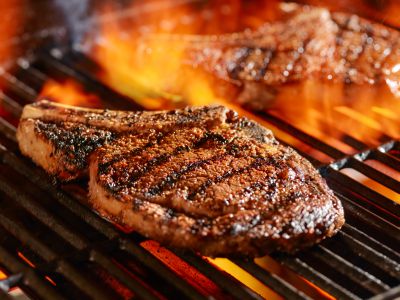
When preparing your ribeye steak, the first step is to let it sit out and reach room temperature. Cooking the steak at room temperature allows it to sear properly over high heat and cook evenly without drying out.
Next, season the steak generously—you can use your favorite steak rub, or keep it simple with salt, freshly ground black pepper, and paprika for a classic flavor.
Finally, lightly coat the steak with olive oil. Olive oil promotes better searing while adding a subtle richness to the meat, boosting its texture and flavor.
If you don’t have olive oil, any other vegetable oil will do. Don’t use butter because it burns too easily and prevents a good crust from forming due to its low smoke point.
Preparing the Grill
You want your grill to be extremely hot before cooking your ribeye, around 450 to 500°F (230 to 260°C). Once the grill is hot, brush the grates with vegetable oil to create a non-stick surface.
Choosing Your Grill Type
Choosing the right grill for your ribeye boils down to two factors: your cooking style and flavor preferences. Here are the common types of grills available:
Charcoal

Charcoal adds a rich, smoky flavor to your steak that’s hard to replicate with other cooking methods. To achieve the best results, you’ll want to get the coals as hot as possible and as close to the cooking grate as you can. This creates the Maillard reaction, which gives your steak a brown, crusty exterior.
Lump charcoal burns hotter and cleaner than briquettes, allowing you to achieve the high temperatures needed for a beautiful sear on your ribeye.
If you want to impart a subtle sweet and fruity smoke flavor to your ribeye, Applewood Charcoal is the no-brainer choice. Conversely, Hickory adds strong, savory, and slightly bacon-like smokiness to steak’s beefy flavor. Oak is a good balance between the two, adding moderate smokiness to the meat.
Gas
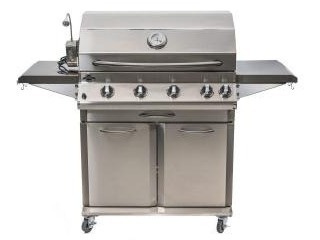
Gas grills are convenient and quick to heat up, making them suitable for everyday grilling. They provide consistent heat and allow precise temperature control, which is great for evenly cooking a ribeye steak.
Gas grills are great for beginners because their precise temperature control makes it easy to achieve ideal searing and doneness, unlike charcoal which requires a more hands-on heat management.
Propane
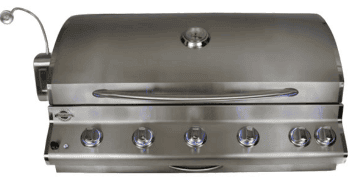
Propane grills are much like gas grills in terms of convenience and ease of use. The only difference is that propane grills are generally more fuel-efficient than natural gas grills because propane produces more heat for the same amount of fuel.
Electric
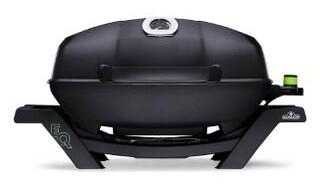
Electric grills are suitable for apartments and complexes that don’t always allow grills that use fire on the property. They’re generally safer than any other type of grill because they don’t come with combustible fuels or flames. They’re also the most convenient type of grill because they don’t require any setup; simply plug them in an electric outlet and wait for them to heat up.
The disadvantage of electric grills is that they don’t provide you with the smoke-infused flavors you get from a charcoal grill or pellet grill. Even gas and propane grills, while not as smoky as charcoal or pellet grills, can still add some flavor to your ribeye.
Still, this just means that you’ll get to enjoy the ribeye steak flavor in its purest form, without the addition of external heating sources.
Pellet
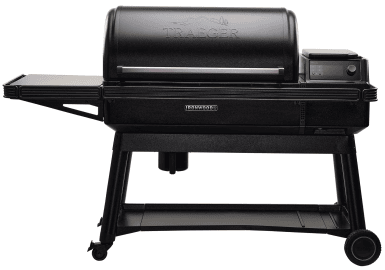
Pellet grills are the next best thing for smokiness if you don’t have a charcoal grill. They basically combine the smoky flavor of charcoal with the convenience of gas. They’re also a lot more eco-friendly than charcoal because the pellets give off fewer emissions.
The only disadvantage of pellet grills is that they cook at lower temperatures than any other type of grill. Most have a maximum temperature of 450°F (230°C) so they’re not the best for high-heat searing. This means that while it can cook a ribeye to a desired internal temperature, it won't achieve the same level of browning and crust formation as a gas or charcoal grill.
Grilling Techniques
I’ve tried dozens of grilling techniques for ribeye, but I’ve found this method works best: Brush a small amount of olive oil on the grill grates and place the ribeye steak over direct high heat. The grill should be between 450°F to 500°F (230°C to 260°C).
Let the steak cook for 2 to 4 minutes until a sear forms, then flip it over and cook for another 2 to 4 minutes. After searing, move the steak to a cooler part of the grill and let it cook to your desired doneness. This technique is known as two-zone cooking.
Cooking Temperatures for Ribeye Steak
Your cooking temperature for ribeye steak depends on the level of your desired doneness. Here’s a chart to help you get the ideal temperature. Always use a meat thermometer to measure the internal temperature of your meat.
| Doneness | Remove from Grill | Final Cooked Temperature |
|---|---|---|
| Rare | 125 to 130°F (52 to 54°C) | 130 to 135°F (54 to 57°C) |
| Medium Rare | 130 to 135°F (54 to 57°C) | 135 to 145°F (57 to 63°C) |
| Medium | 135 to 140°F (57 to 60°C) | 145 to 150°F (63 to 66°C) |
| Medium Well | 140 to 150°F (60 to 66°C) | 150 to 160°F (66 to 71°C) |
| Well Done | 150°F and above (66°C and above) | 160°F and above (71°C and above) |
The final cooked temperature is always higher than the temperature of the meat when removed from the grill because the meat continues to cook as the steak rests. The heat from the outer layers transfers to the center, raising its internal temperature by a few degrees.
So whenever you’re cooking steak, remove it from the grill a few degrees before reaching your desired doneness to account for carryover cooking.
Cooking Times
The cooking time varies depending on the thickness of the steak and the level of doneness you want to achieve.
Here are the approximate cooking times for a 1-inch steak. Note that these cooking times are for the indirect heat portion of the cooking process, after the steak has been seared.
- Rare: 3 to 4 minutes on each side, totaling 6 to 8 minutes
- Medium-rare: 4 to 5 minutes on each side, totaling 8 to 10 minutes
- Medium: 5 to 6 minutes on each side, totaling 10 to 12 minutes
- Medium-well: 6 to 7 minutes on each side, totaling 12 to 14 minutes
- Well done: 7 to 8 minutes on each side, totaling 14 to 16 minutes
Note: For ribeye steaks thicker than 1 inch, add an additional 3 to 4 minutes of cooking time on the indirect heat side for every extra half-inch of thickness. The searing time remains the same at about 2 to 3 minutes per side.
Rest Times after Cooking
While it’s tempting to eat a ribeye steak straight out of the pan, resting the meat after cooking is essential to achieve the best texture and flavor.
When the steak is cooked, the heat forces the juices to the center of the meat. If you cut into the steak immediately, those juices will spill out, leaving the meat dry and less flavorful. Resting the steak lets the juices redistribute throughout the meat, making sure that each bite is juicy and tender.
For ribeye steak, rest the meat for five minutes per inch of thickness. This means that for a 2-inch steak, the meat has to rest for about 10 minutes. Loosely cover the meat with a foil or a lid to retain the heat and prevent it from getting too cold.
Use the 5 to 10 minutes wait time to prepare a sauce, make a salad, set the table, or get your baked potatoes ready. Or, you can just pour yourself a drink while waiting for the meat to rest—a reward for making a super delicious steak!
Side Dishes for Steak
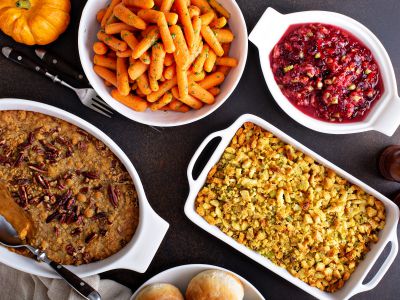
Ribeye steak tastes best with side dishes that balance the richness of the meat and add texture and flavor to the meal. Here are some of the best side dishes for ribeye steak:
Mashed Potatoes
Steak and mashed potato go beautifully well together.
You can go with the simple warm milk and butter pairing or swap milk for heavy cream and add roasted garlic to the mash. You can add chopped chives and pieces of bacon to add richness to the mashed potatoes.
Baked Sweet Potatoes
Not a fan of mashed potatoes? Baked sweet potatoes are the next best thing.
Preheat the oven to 425°F (220°C), then line a baking sheet with aluminum foil or parchment paper. Lightly coat it with cooking spray.
Make about eight crosswise slashes up and down each potato, then rub the skins with olive oil and sprinkle salt and pepper.
Bake for 30 minutes or until a fork is easily inserted in the center of the potato. Pull out of the oven and season with butter, brown sugar, and any other topping of your choice.
Mac and Cheese
Who doesn’t love Mac and Cheese with ribeye steak? It’s an indulgent side dish that everyone loves. And since you’re eating it with ribeye steak, ditch the instant mac-and-cheese and create one yourself from scratch.
There are thousands of recipes online boasting to be the best homemade Mac and Cheese recipe, but I personally love Snoop Dog’s recipe that combines heavy cream, extra sharp cheddar, shredded colby jack, and sour cream to elbow macaroni.
You can find the full recipe here.
Salad
I’m partial to Caesar salad, but any salad will do, really. Pairing grilled meat with salad adds a fresh contrast to the steak’s richness without overpowering the flavors. Here are some great salads that pair with ribeye:
- Cold broccoli salad
- Cucumber salad
- Arugula salad with roasted peppers
- Spinach salad
- Roasted beet salad
- Coleslaw
- Cucumber tomato avocado salad
- Mexican street corn pasta salad
- Grilled peach salad
- Lemony chickpea salad
Vegetable Sides
Veggies add color to your dish and prevent the meal from being too heavy. They also add a welcome texture to the plate, giving the dish a pleasant crunch, crispness, or tenderness, depending on the vegetable. Here’s a list of excellent vegetable sides to pair with ribeye:
Parmesan Roasted Broccoli: Toss broccoli florets in olive oil, salt, and pepper. Roast in a preheated oven at 400°F (200°C) for 20 to 25 minutes until crispy and tender. Sprinkle with grated Parmesan cheese before serving.
Oven-roasted Peppers, Onions, Mushrooms, or Zucchini: Slice your chosen vegetables and toss with olive oil, salt, pepper, and your favorite herbs. Roast in a preheated oven at 425°F (220°C) for 20 to 25 minutes until caramelized and tender, stirring halfway through.
Buttery Sautéed Mushrooms and Onions with Fresh Herbs: In a pan, melt butter over medium heat. Add sliced mushrooms and onions and cook until soft, about 8 to 10 minutes. Stir in fresh thyme or rosemary and season with salt and pepper.
Sautéed Green Beans: Heat olive oil or butter in a skillet over medium heat. Add fresh green beans and cook for 5 to 7 minutes until tender-crisp. Season with salt, pepper, and a squeeze of lemon juice.
Grilled Asparagus: Toss asparagus in olive oil, salt, and pepper, and grill over medium heat for about 5 to 7 minutes until tender with a slight char. The smoky flavor and crunch balance the steak's richness.

